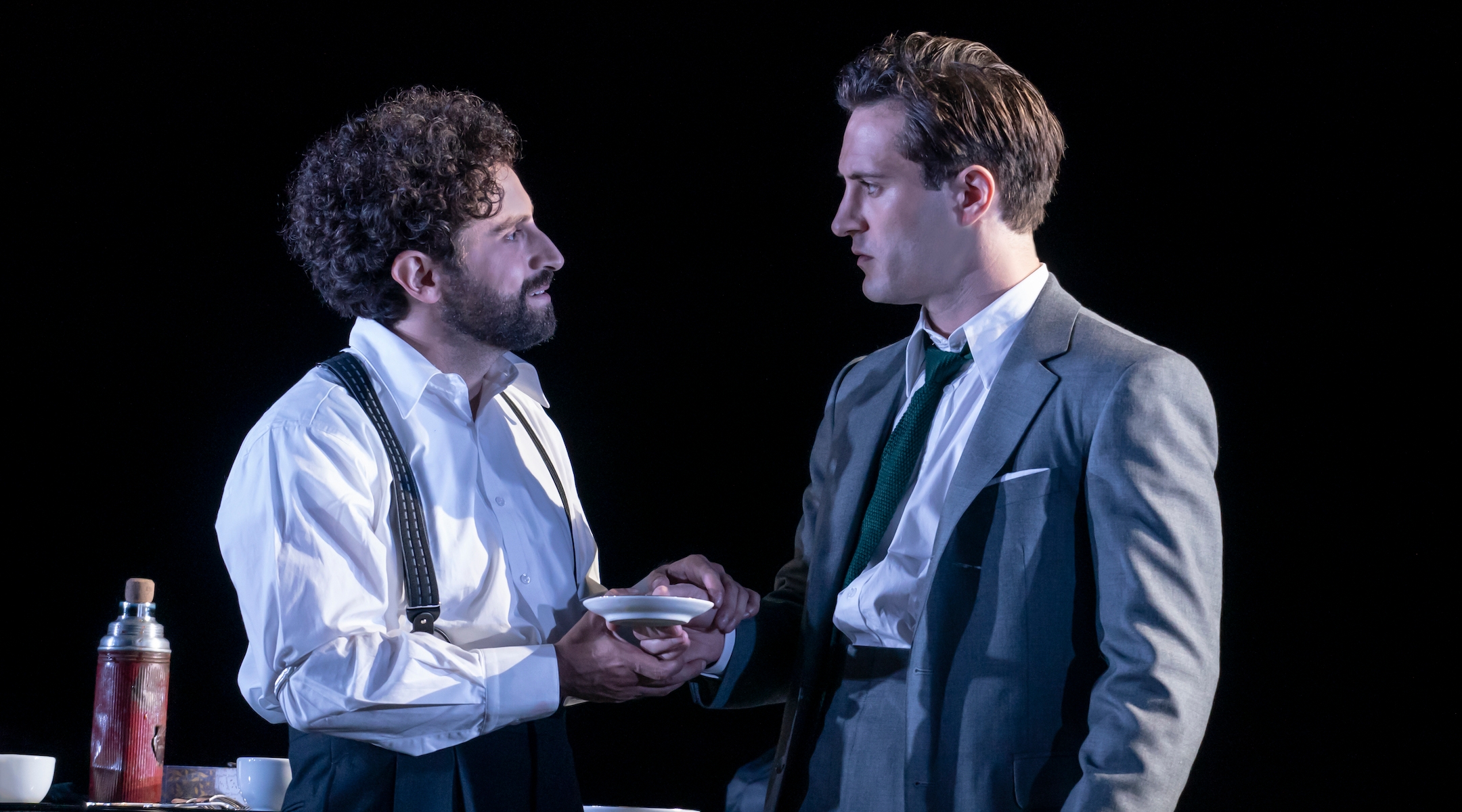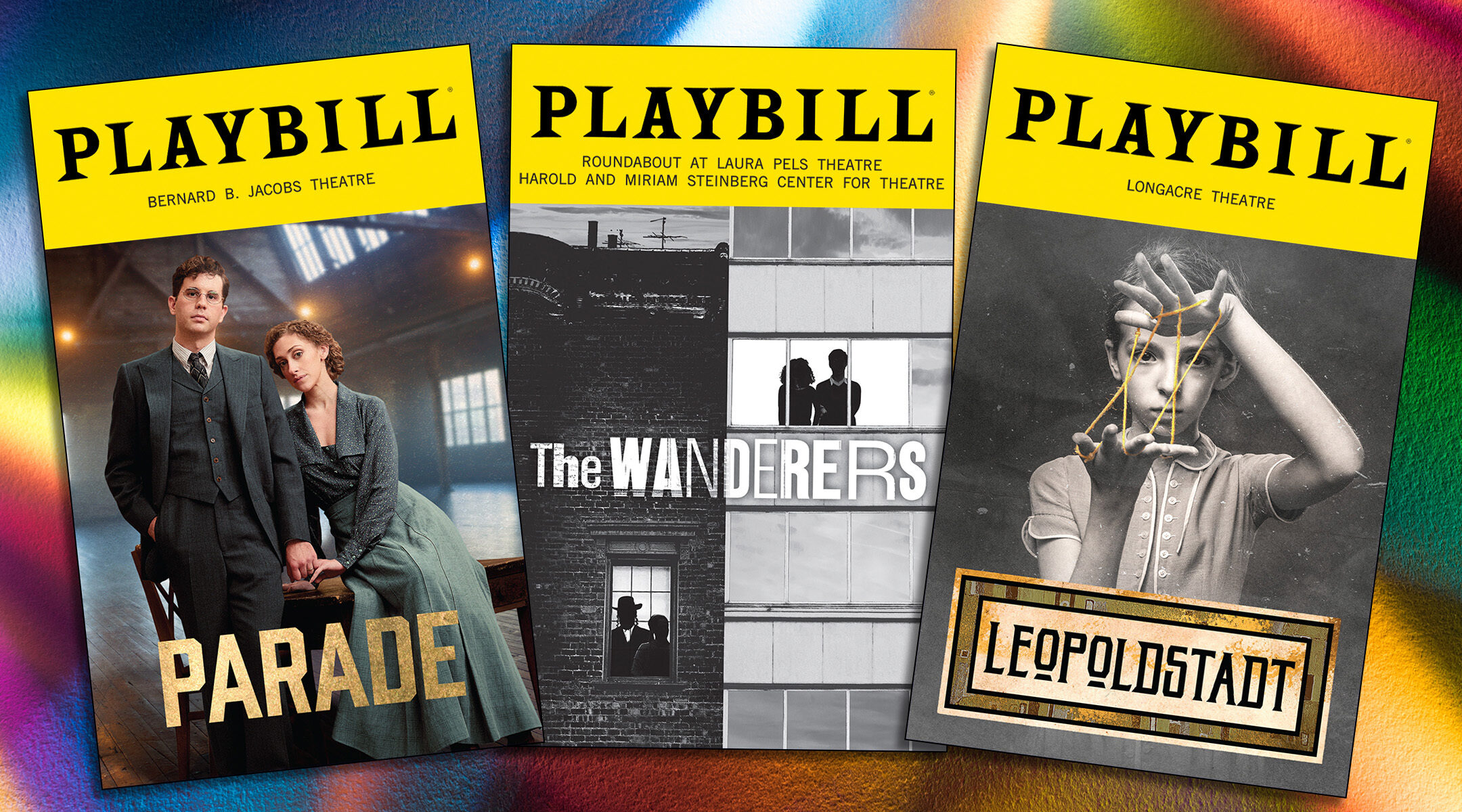(JTA) — Jewish stories have had top billing on Broadway this season — and Jewish audiences have been flocking to the theater.
Audiences have lined up to see Tom Stoppard’s “Leopoldstadt,” the multigenerational saga of a Jewish family in Vienna, and the devastating consequences of the Holocaust upon its ranks. They have packed the house for “Parade,” a musical retelling of the infamous antisemitic show trial and subsequent lynching of Leo Frank in Marietta, Georgia, in 1915. And just off Broadway, “The Wanderers” (which closed April 2) invited us into the slowly disintegrating marriage of two secular Jews born to mothers who dramatically left the Satmar sect of ultra-Orthodox Judaism, a show replete with intergenerational trauma and a pervasive sense of ennui.
None of these shows offers a particularly lighthearted evening at the theater. So why have they proven so popular? Critics have penned countless reviews of the three plays, analyzing the quality of the productions, the scripts, scores, performances of principal actors, set and design. But for our new book exploring what audiences learn about Judaism from Jewish cultural arts, my colleague Sharon Avni and I have been interviewing audience members after seeing “Leopoldstadt,” “Parade” and “The Wanderers.” We are interested in turning the spotlight away from the stage and onto the seats: What do audiences make of all this? What do they learn?
Take “Leopoldstadt,” for example, a drama so full of characters that when it left London for its Broadway run the production team added a family tree to the Playbill so that theatergoers could follow along. “Leopoldstadt” offers its audience a whistle-stop introduction to modern European Jewish history. In somewhat pedantic fashion, the family debates issues of the day that include Zionism, art, philosophy, intermarriage and, in a searing final scene, the memory of the Holocaust.
For some of the theatergoers that we interviewed, “Leopoldstadt” was powerful precisely because it packed so much Jewish history into its two-hour run time. It offered a basic literacy course in European Judaism, one they thought everyone needed to learn. Others, however, thought that this primer of Jewish history was really written for novice audiences — perhaps non-Jews, or assimilated Jews with half-remembered Jewish heritage, like Stoppard himself. “I don’t know who this play is for,” one interviewee told us. “But it’s not me. I know all this already.”

Brandon Uranowitz, left, who plays a Holocaust survivor, confronts Arty Froushan as a young writer discovering his Jewish roots, in the Broadway production of Tom Stoppard’s “Leopoldstadt.” (Joan Marcus)
Other interviewees thought the power of “Leopoldstadt” lay not in its history lessons, but in its ability to use the past to illuminate contemporary realities. I spoke at length with a woman who had been struggling with antisemitism at work. Some of her colleagues had been sharing social media posts filled with lazy caricatures of Jews as avaricious capitalists. Upon seeing “Leopoldstadt,” she realized that these vile messages mirrored Nazi rhetoric in the 1930s, convincing her that antisemitism in contemporary America had reached just as dangerous a threshold as beheld European Jews on the eve of the Shoah.
We heard similar sentiments about the prescience of history to alert us to the specter of antisemitism today from audiences who saw “Parade.” Recalling a scene where the cast members wave Confederate flags during the titular parade celebrating Confederate Memorial Day, Jewish audiences recalled feeling especially attuned to Jewish precarity when the theater burst into applause at the end of the musical number. “Why were we clapping Confederate flags?” one of our interviewees said. “I’ve lived in the South, and as a Jew I know that when you see Confederate flags it is not a safe space for us.”
“Parade” dramatizes the popular frenzy that surrounded the trial of Leo Frank, a Yankee as well as a Jew, who was scapegoated for the murder of a young Southern girl. Jewish audience members that we interviewed told us that the play powerfully illustrated how crowds could be manipulated into demonizing minorities, comparing the situation in early 20th century Marietta to the alt-right of today, and the rise of antisemitism in contemporary America.
What we ultimately discovered, however, was that audience perceptions of the Jewish themes and characters in these productions were as varied as audiences themselves. Inevitably, they tell us more about the individual than the performance. Yet the fact that American Jews have flocked to these three shows — a secular pilgrimage of sorts — also illustrates the power and the peril of public Jewish storytelling. For audience members at “Leopoldstadt” and “Parade,” especially, attending these performances was not merely an entertaining evening at the theater. It was a form of witnessing. There was very little to be surprised by in these plays, after all. The inevitable happens: The Holocaust destroys Jewish life in Europe, Leo Frank is convicted and lynched. Jewish audiences know to expect this. They know there will be no happy ending. In the secular cultural equivalent to saying Kaddish for the dead, Jewish audiences perform their respect to Jewish memory by showing up, and by paying hundreds of dollars for the good seats.
The peril of these performances, however, is that audiences learn little about antisemitism in reality. The victims of the Nazis and the Southern Jews of Marietta would tell us that they could never have predicted what was to happen. Yet in “Parade” and “Leopoldstadt” audiences are asked to grapple with the naivete of characters who believe that everything will be all right, even as audiences themselves know that it will not. By learning Jewish history on Broadway, audiences are paradoxically able to distance themselves from it, simply by knowing too much.
In the final scene of “Leopoldstadt,” Leo, the character loosely based on Stoppard himself, is berated by a long-lost relative for his ignorance of his family’s story. “You live as if without history,” the relative tells Leo. “As if you throw no shadow behind you.” Audiences, at that moment, are invited to pat themselves on the back for coming to see the show, and for choosing to acknowledge the shadows of their own Jewish histories. The cold hard reality, however, is that a shadow can only ever be a fuzzy outline of the truth.
JTA has documented Jewish history in real-time for over a century. Keep our journalism strong by joining us in supporting independent, award-winning reporting.







